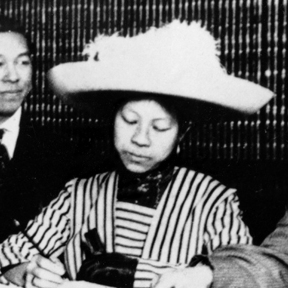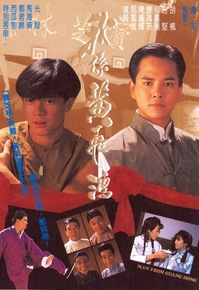
Chinatown is a neighbourhood in Vancouver, British Columbia, and is Canada's largest Chinatown. Centered around Pender Street, it is surrounded by Gastown to the north, the Downtown financial and central business districts to the west, the Georgia Viaduct and the False Creek inlet to the south, the Downtown Eastside and the remnant of old Japantown to the northeast, and the residential neighbourhood of Strathcona to the southeast.

Clara Elizabeth Chan Lee was the first Chinese American woman to register to vote in the United States. She registered to vote on November 8, 1911 in California following the passage of Proposition 4 in California, nine years before the passage of the Nineteenth Amendment to the United States Constitution.

The Bronze Bauhinia Star is the lowest rank in Order of the Bauhinia Star in Hong Kong, created in 1997 to replace the British honours system of the Order of the British Empire after the transfer of sovereignty to People's Republic of China and the establishment of the Hong Kong Special Administrative Region (HKSAR).
A list of awards given to members of the Hong Kong Civil Service:

The Legend of the Condor Heroes is a Hong Kong television series adapted from Louis Cha's novel of the same title. The series was first broadcast on TVB Jade in 1994.

He Ain't Heavy, He's My Father, also known as He Ain't Heavy, He's My Brother (新難兄難弟), is a 1993 Hong Kong comedy-drama film directed by Peter Chan and Lee Chi-ngai and starring Tony Leung Ka-fai, Tony Leung Chiu-wai, Carina Lau, Anita Yuen and Lawrence Cheng. The title is a pun of "He Ain't Heavy, He's My Brother", a hit single for The Hollies in 1969 and for Neil Diamond in 1970.
Paul Yee is a Chinese-Canadian historian and writer. He is the author of many books for children, including Teach Me to Fly, Skyfighter, The Curses of Third Uncle, Dead Man's Gold, and Ghost Train—winner of the 1996 Governor General's Award for English language children's literature. In 2012, the Writers' Trust of Canada awarded Paul Yee the Vicky Metcalf Award for Literature for Young People in recognition of having "contributed uniquely and powerfully to our literary landscape over a writing career that spans almost 30 years".

New Heavenly Sword and Dragon Sabre is a Hong Kong television series adapted from Louis Cha's novel The Heaven Sword and Dragon Saber. The series was first broadcast on TVB Jade in Hong Kong in 1986.

State of Divinity is a Hong Kong television series adapted from Louis Cha's novel The Smiling, Proud Wanderer. It was first broadcast on TVB in Hong Kong in 1996.

The Conqueror's Story is a Hong Kong television series based on the events in the Chu–Han Contention, an interregnum between the fall of the Qin dynasty and the founding of the Han dynasty in Chinese history. It was first broadcast in 2004 in Hong Kong on TVB Jade.

Story of the Vulture Conqueror is a two-part Hong Kong film adapted from Louis Cha's novel The Legend of the Condor Heroes. The first part was released in 1958 while the second part was released in the following year. The film was directed by Wu Pang and starred Cho Tat-wah and Yung Siu-yee in the leading roles.
Taishanese people or Sze Yup people are a Han Chinese group coming from Sze Yup, which consisted of the four county-level cities of Taishan, Kaiping, Xinhui and Enping. Now Heshan has been added to this historic region and the prefecture-level city of Jiangmen administers all five of these county-level cities, which is sometimes informally called Ng Yap. Their ancestors are said to have arrived from what is today central China about less than a thousand years ago and migrated into Guangdong around the Tang Dynasty rule period and thus Taishanese as a dialect of Yue Chinese has linguistically preserved many characteristics of Middle Chinese.
The Hong Kong Special Administrative Region Basic Law Consultative Committee was an official body established in 1985 to canvass views in Hong Kong on the drafts of the Hong Kong Basic Law.
The history of Chinese Canadians in British Columbia began with the first recorded visit by Chinese people to North America in 1788. Some 30–40 men were employed as shipwrights at Nootka Sound in what is now British Columbia, to build the first European-type vessel in the Pacific Northwest, named the North West America. Large-scale immigration of Chinese began seventy years later with the advent of the Fraser Canyon Gold Rush of 1858. During the gold rush, settlements of Chinese grew in Victoria and New Westminster and the "capital of the Cariboo" Barkerville and numerous other towns, as well as throughout the colony's interior, where many communities were dominantly Chinese. In the 1880s, Chinese labour was contracted to build the Canadian Pacific Railway. Following this, many Chinese began to move eastward, establishing Chinatowns in several of the larger Canadian cities.
Chinese Canadians are a sizable part of the population in Greater Vancouver, especially in the Chinese communities in the city of Vancouver and the adjoining suburban city of Richmond. The legacy of Chinese immigration is prevalent throughout the Vancouver area.

The election for the Hong Kong deputies to the 10th National People's Congress (NPC) was held on 3 December 2002. 36 Hong Kong deputies were elected by an electoral college.

Man from Guangdong is a 1991 Hong Kong martial arts television series produced by TVB and tells the story of Leung Kan, portrayed by Aaron Kwok, the fictitious son of famed martial artist Leung Foon, whom was a favored disciple of folk hero Wong Fei-hung, portrayed by Shih Kien. Shih, who portrayed Wong in the series, was known for portraying antagonists in a series of Wong Fei-hung-related films during the 1940s to 1970s, while the series also features Sai Gwa-Pau reprising his role as "Buckteeth So" from the aforementioned series of films.

Mon Keang School is a Chinese language school located in the Wong Benevolent Association Building at 121 East Pender Street, in the Chinatown of Vancouver, British Columbia.












